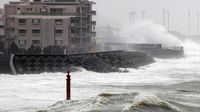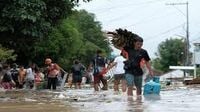On the weekend of October 18-19, 2025, Tropical Storm Fengshen—known locally in the Philippines as Ramil—unleashed a torrent of rain and wind across the northern and central regions of the country, leaving a trail of devastation in its wake. By the time the storm had blown out of Luzon and into the South China Sea late Sunday, at least seven people were confirmed dead, thousands had been forced from their homes, and communities were left grappling with the aftermath of yet another natural disaster.
According to the Philippine government’s disaster-mitigation agency, more than 22,000 people were evacuated from flood- and landslide-prone villages as Fengshen approached, with nearly 14,000 evacuees still unable to return home by Monday, October 20. The storm, the 18th tropical cyclone to batter the archipelago in 2025, struck at a time when central and southern provinces were still reeling from recent earthquakes that had left more than 80 people dead and damaged over 134,000 houses in central Cebu province alone, as reported by the Associated Press and Vietnam News Agency.
In Capiz province, the situation quickly turned dire. Continuous rains from Fengshen submerged large swathes of Pontevedra and Roxas City, prompting the Capiz Provincial Disaster Risk Reduction and Management Office (PDRRMO) to declare a state of calamity. The flooding was so severe that Roxas City, which had recorded only 305 millimeters of rain in the first half of October, was deluged by nearly 400 millimeters in a single day—more than the city’s typical monthly total for October, according to the Philippine Daily Inquirer.
Tragedy struck in multiple locations. In Roxas City, one person drowned on Saturday, October 18, after being swept away by floodwaters made more treacherous by a high tide. Four more fatalities in Capiz were later confirmed, including a 44-year-old man from Roxas City and a 45-year-old man from Pilar town who was electrocuted. Two additional deaths in Roxas City were still being verified by authorities as of late Sunday. The total death toll attributed to Fengshen in Capiz alone rose to five by October 20, bringing the nationwide storm-related fatalities to ten, as reported by local officials.
Elsewhere, in Pitogo town, Quezon province, a family of five—two adults and two children among them—died in their sleep when a massive palm tree, weakened by the storm, crashed onto their home. According to provincial police chief Romulo Albacea, the family had attempted to burn the tree earlier, hoping to topple it safely before it could cause harm. Their tragic deaths were echoed in multiple news outlets, including the Associated Press and Vietnam News Agency, highlighting the unpredictable and often cruel consequences of such storms.
The impact on communities was enormous. Floods affected 3,307 families—amounting to 9,665 individuals—across 61 barangays in Capiz, with more than 800 families in Roxas City alone requiring rescue as floodwaters swept through their neighborhoods. Hundreds of commuters found themselves stranded as public and private vehicles became stuck on impassable, flooded roads. In response, classes at all educational levels were suspended from October 20 through October 22, as authorities closely monitored river and canal water levels and continued to urge residents to remain vigilant, avoid crossing flooded areas, and evacuate when necessary. Relief goods were distributed at evacuation centers, and search and rescue teams remained on high alert, ready to respond to worsening conditions.
Fengshen’s reach extended well beyond the Philippines. As the storm moved northwestward at speeds of 25 to 30 kilometers per hour, China’s national observatory issued a blue typhoon alert on October 20—the lowest tier in its four-level, color-coded warning system. According to Chinese authorities, Fengshen was expected to intensify into a severe tropical storm or even a typhoon as it traversed the Taiwan Strait, South China Sea, and East China Sea, threatening the coastal provinces of Zhejiang, Fujian, and Guangdong. Taiwan, in particular, braced for heavy rainfall, with forecasts of 100 to 200 millimeters in some areas. The storm’s wind field stretched between 220 and 280 kilometers from its center, with maximum sustained winds reported at 82 kilometers per hour by Chinese meteorological agencies.
Back in the Philippines, the scale of displacement was staggering. The National Disaster Risk Reduction and Management Council (NDRRMC) reported that 37,852 families were affected by the storm over the weekend. In Western Visayas, two people remained missing, and one injury was reported in Calabarzon, adding to the sense of unease as search and rescue operations continued. The storm’s local name, Ramil, became a byword for hardship across regions that have seen more than their fair share of calamity in recent months.
As Fengshen moved out of the Philippines, meteorologists warned that the storm would likely move southwestward over the northern parts of the South China Sea from October 21, heading toward Vietnam before gradually weakening. Yet, for many in the Philippines, the end of the storm’s passage brought little relief. The country, situated between the Pacific Ocean and the South China Sea, is battered by about 20 typhoons and storms each year, making it one of the world’s most disaster-prone nations. It is also frequently hit by earthquakes and has around two dozen active volcanoes, compounding the risks faced by its population.
The rapid succession of disasters—earthquakes, typhoons, and floods—has tested the resilience of Filipino communities and the capacity of local governments to respond. Relief efforts, including the distribution of food, water, and other necessities, have been ongoing, but the challenges of rebuilding in the wake of repeated catastrophes are immense. As officials continue to tally the damage and search for the missing, the stories of loss and survival serve as a sobering reminder of the vulnerabilities faced by millions living in the path of nature’s fury.
While Fengshen’s winds may have moved on, the effects of the storm will linger for weeks and months to come. For the families who lost loved ones, the communities submerged by floodwaters, and the thousands still seeking shelter, the road to recovery will be long and arduous. Yet, as history has shown time and again, the Filipino spirit is remarkably resilient—even in the face of relentless adversity.


